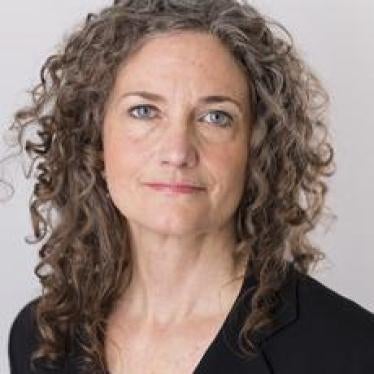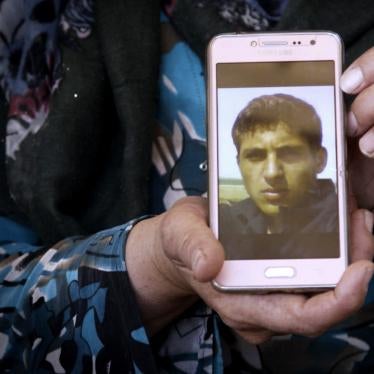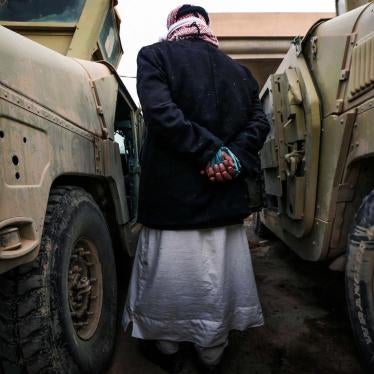(Sanaa) — The villagers who rushed to the road, cutting through rocky fields in central Yemen, found the dead strewn around a burning sport utility vehicle. The bodies were dusted with white powder -- flour and sugar, the witnesses said -- that the victims were bringing home from market when the aircraft attacked. A torched woman clutched her daughter in a lifeless embrace. Four severed heads littered the pavement.
"The bodies were charred like coal. I could not recognize the faces," said Ahmed al-Sabooli, 22, a farmer whose parents and 10-year-old sister were among the dead. "Then I recognized my mother because she was still holding my sister in her lap. That is when I cried."
Quoting unnamed Yemeni officials, local and international media initially described the victims of the Sept. 2 airstrike in al-Bayda governorate as al Qaeda militants. After relatives of the victims threatened to bring the charred bodies to the president, Yemen's official news agency issued a brief statement admitting the awful truth: The strike was an "accident" that killed 12 civilians. Three were children.
Nearly four months later, that terse admission remains the only official word on the botched attack. A Washington Post article, published on Dec. 24, reports that "U.S. officials in Washington, who spoke on the condition of anonymity because of the sensitivity of the matter, said it was a Defense Department aircraft, either a drone or a fixed-wing airplane, that fired" on the vehicle. But the people of al-Bayda still have received no official word as to who was responsible for the deaths -- the United States, which in the past year has accelerated its covert targeted-killing program against Yemeni-based al Qaeda in the Arabian Peninsula; or the Yemeni government, whose new president, Abd al-Rab Mansur al-Hadi, was installed with Washington's help.
The information blackout on terrorism-related killings is not limited to al-Bayda. The United States has revealed only the barest details of its 400 estimated strikes on alleged militant targets in Pakistan, Yemen, and Somalia over the past decade. The attacks, carried out by the CIA and the Pentagon with unmanned aerial vehicles (drones), manned warplanes, and cruise missiles, have reportedly killed at least 2,800 people, according to sources such as the Bureau of Investigative Journalism (TBIJ) in London. Yet in most cases, Washington refuses to even confirm or deny any role in the strikes, much less acknowledge whether any civilians were killed. With the United States leading the way on obfuscation, allies such as Yemen have no qualms about following suit, leaving no one accountable when attacks kill the wrong people.
U.S. President Barack Obama's administration is reportedly drafting new rules on targeted killings, the majority of which have been conducted on his watch. But though these new rules might include more oversight, it's likely that the program will remain shrouded in secrecy. For the people of al-Bayda, just a pinprick on the map of innocents lost to the "war on terror," policy changes without more transparency mean nothing.
During a trip to Yemen for Human Rights Watch in October, I spoke with four people, including Sabooli, who witnessed the al-Bayda attack. The witnesses drove 10 hours round-trip to see me in Sanaa, the Yemeni capital, after Human Rights Watch decided it was too dangerous for me to travel to al-Bayda, an area outside the government's control with a known al Qaeda presence and a reputation for kidnappings.
Without visiting the scene of the attack, we were unable to determine what kind of aircraft carried out the strike and whether it dropped a bomb or fired missiles. But the witnesses provided some important clues, including the presence of what they said were drones, during the attack. Only the United States is known to operate drones in Yemen, home to what Washington calls al Qaeda's most active affiliate.
The attack took place near Radda, a hilltop city roughly 100 miles southeast of Sanaa. For more than a year, drones had been circling day and night over Radda and surrounding areas, and one or two had been flying overhead on the morning of Sept. 2, the witnesses said. Shortly before 4 p.m., three of the witnesses said, two warplanes also swooped into the area. (The Washington Post article notes that some witnesses saw three planes.)
"I heard a very loud noise, like thunder," said Sami al-Ezzi, a farmer who was working in his fields in Sabool, a farming village six miles from Radda. "I looked up and saw two warplanes. One was firing missiles."
Arriving at the scene, about 1.5 miles from Sabool, local residents found a horrific sight: The battered Toyota Land Cruiser that had served as the daily shuttle between Sabool and Radda lay on its side in flames. All the dead and injured were Sabool residents returning from Radda.
"About four people were without heads. Many lost their hands and legs," said Nawaf Massoud Awadh, a sheikh from Sabool who saw the attack. "These were our relatives and friends."
Sabooli's mother was in the vehicle because her husband had taken her to Radda to see a doctor. Other passengers were farmers who had gone to Radda to sell their crop of khat, a legal and widely used stimulant in Yemen. Only two passengers, both men, survived. Both lost their ability to walk, the witnesses said.
The witnesses who met me in Sanaa brought along videos showing the Land Cruiser overturned and in flames, near two craters created by the strike -- one immediately behind the vehicle and the other nearby. Bodies lay on the ground in contorted heaps.
"Push! Push!" "Open the door!" local residents are heard crying. Seeking to extinguish the flames, they urged, "Bring sand!"
One video shows a man pulling a Kalashnikov assault rifle from the wreckage and throwing it aside. (This may seem like a smoking gun, but it's common for men to be armed with assault rifles in tribal areas of Yemen such as al-Bayda that are outside government control.)
The Sept. 2 strike was the seventh in al-Bayda that local or international media had attributed to U.S. or Yemeni forces since January 2012. That month, a band of militants from al Qaeda in the Arabian Peninsula took control of Radda for 10 days -- some accounts say with help from loyalists of the former president, Ali Abdullah Saleh, who were trying to spoil Yemen's political transition. After being forced out by local tribal leaders, many militants reportedly disappeared into the surrounding villages.
The attack's reported target was Abdulraouf al-Dahab, an alleged al Qaeda militant whose brother led the January takeover of Radda. Dahab is from Manasseh, a village about 14 kilometers from Radda. The attack took place as the shuttle approached an intersection where one road led to Sabool and the other to Manasseh. But witnesses, as well as unnamed government officials quoted by media, said Dahab was not inside the Land Cruiser. Nor was the SUV even traveling to Manasseh; it was completing its daily round trip between Sabool and Radda. A Yemeni newspaper reported that Dahab was killed in a U.S. drone strike in Radda six days later, but some residents of the Radda area say he is still alive.
Media reports, quoting unnamed Yemeni officials, attributed the Sept. 2 attack to U.S. drones; others to manned warplanes. Two witnesses told me they saw warplanes fire munitions that they thought were bombs and missiles. Two witnesses also told me they saw a black tail fin near the burning SUV. (A black tail fin is typical of a Hellfire, a U.S. missile that can be fired by either drones or jet fighters.) The shrapnel that witnesses brought us from the site, however, is more consistent with the type of damage caused by a bomb -- which would point to an attack by manned jets. But even these scraps of information are inconclusive: Yemen's air force has fighter jets, while the United States reportedly flies F-15E Strike Eagles (as well as armed and surveillance drones) over Yemen from a military base in Djibouti.
On one of the videos I reviewed, two men are heard saying that a warplane with "two exhausts in the back" -- presumably twin engines -- fired munitions at the vehicle while other aircraft were circling. The men's agitated exchanges underscore the confusion in Yemen over who is conducting such attacks.
"It's our government; it's our government," one man says.
"It's America; it's America," the other responds.
Media reports quoting Yemeni officials as saying Yemeni warplanes carried out the attack also provide no clear answers. A classified U.S. cable from January 2010, released by WikiLeaks, revealed that Yemen has previously covered up for U.S. targeted killings gone awry. As the cable relates, Saleh, president at the time, was talking to Gen. David Petraeus, who was then the head of U.S. Central Command. The two officials were discussing a botched airstrike in late 2009 that killed 41 civilians in southern Abyan governorate. "We'll continue saying the bombs are ours, not yours," said Saleh.
Yemen has a long, painful history in the U.S. war on terror that includes being the site of the first known U.S. drone strike against a terrorist target. The attack, 10 years ago, killed reputed al Qaeda leader Qaed Salim Sinan al-Harethi, along with five other alleged militants. The United States carried out its next targeted killing in Yemen in 2009 and to date has carried out at least 52 drone strikes and other air attacks there, killing hundreds, according to TBIJ. But lack of access to the attack areas, nearly all of which are too dangerous for international media and investigators to visit, makes it impossible to verify the figures. The same difficulty exists for verifying casualties from U.S. targeted killings in Pakistan and Somalia.
The office of Obama's counterterrorism advisor, John Brennan, declined to comment for this article, saying it does not speak about specific operations. The Yemeni government referred Human Rights Watch to a recent speech in which President Hadi lauded U.S. drone strikes but did not respond to specific questions about the al-Bayda attack.
U.S. officials, including Brennan, argue that the United States has authority under both domestic and international law to conduct targeted killings because the country is at war with al Qaeda and its affiliates. International law permits targeted killings of enemy fighters in battle zones and of people posing an imminent risk to life in law enforcement situations. However, U.S. officials have failed to explain how they make this determination in areas that are far from a traditional battlefield.
Washington also says that the vast majority of those killed are militants and that civilian casualties are "exceedingly rare." But, citing national security, it refuses to disclose how many militant suspects and civilians it has killed, or the legal basis for placing suspected militants on a kill list. Nor will it detail what steps it takes to minimize civilian casualties or investigate attacks in which civilians are killed.
Governments have an obligation under international law to investigate and provide redress for unlawful attacks. In Afghanistan, NATO members -- including the United States -- have recognized the value of compensating civilians for loss of life or other damage, even when the attacks are lawful.
There is no such formal system in Yemen, leaving the people of Sabool with little more than anger. And with neither Yemeni nor U.S. authorities taking responsibility for the attack, the villagers blame both countries.
The deaths from the September attack have devastated Sabool, a cluster of 120 brick-and-mud homes that residents say has no electricity, no paved roads, no schools, no hospitals, and no jobs apart from khat farming.
"Seven of the victims were breadwinners. Now we have 50 people in our village with no one to care for them," said Awadh, the local sheikh. "Who will raise them? Who will educate them? Who will take care of their needs?"
Sabooli, the farmer whose parents and only sister were killed, said six of his 10 remaining siblings are still too young to fend for themselves. "When I enter our house, my younger brothers still ask, 'Where are my mother, my father, and my sister?'" he said.
Sabool's residents accuse authorities of refusing to take responsibility for the deaths from the start. When distraught villagers tried to bring the dead to the city morgue in Radda, Republican Guard troops blocked their entry for two hours. Then the morgue refused the bodies. The Sabool villagers spent the night on the streets of Radda, fending off stray dogs from the corpses spread out on the beds of pickup trucks. The next day, Radda shopkeepers joined the Sabool residents in blocking the main street in Radda and threatening to bring the bodies to President Hadi's doorstep in Sanaa.
Within hours, Sheikh Sinan Garoon, the deputy governor of al-Bayda, arrived to appease the Sabool residents the tribal way, with 95 Kalashnikovs and 15 million Yemeni rials -- about $70,000 -- in burial money. He also promised further compensation, villagers said.
"We denounce what happened," a video obtained by Human Rights Watch showed Garoon telling the angry demonstrators. "We will give you the guns.… If you demand blood money, it will be given to you."
From Sanaa, Hadi announced he would form a special committee to investigate the attack. But as of late December the panel was not in place, and talks on compensation beyond the initial $70,000 had stalled. "They were toying with us," said Awadh.
"We've had four meetings with Sheikh Garoon, but he said that the government is busy nowadays with more important issues," Sabooli said. "It's as if we live in a jungle and the attack was on wild animals -- no one cares. Both the Yemeni government and the American government killed my family and my villagers. Both of them should be brought to justice."
Letta Tayler is a Senior Researcher in the Terrorism/Counterterrorism division at Human Rights Watch.









